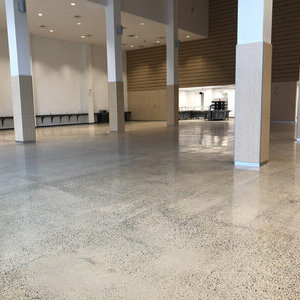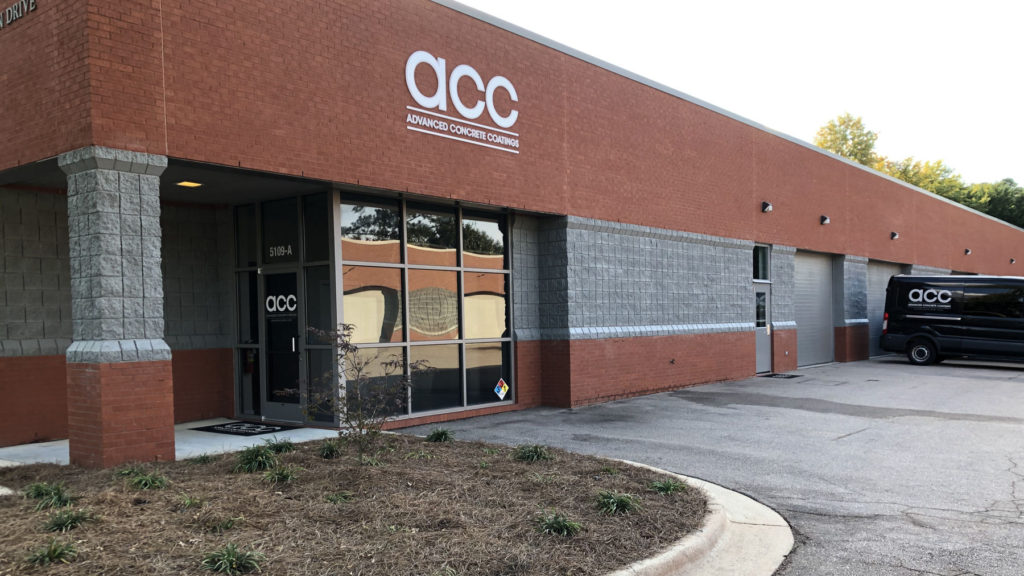The Difference Between Sealed Concrete and Polished Concrete
by Tom Cramsie
The terms “polished” and “sealed” are often interchangeable when used by the customers, builders and architects we interact with. To a concrete polisher, however, these terms have very different implications.
The intent of polishing concrete is to close the concrete’s pore space which will produce a natural shine. But no matter how refined the concrete is, there are still micropores at the surface that are open and susceptible to staining. As such, polished concrete “guards” have been developed. These solvent and water-based guards are applied in very thin coats and perform differently than traditional topical sealers.
To gain a better understanding of sealed vs. polished concrete, a thorough discussion of sealers and the various types is warranted.
Water- Versus Solvent-Based Sealers
Sealers are used to lock-in color, protect the concrete and create a surface that can be easily cleaned. The two basic categories of sealers are water-based and solvent-based. Most UV-resistant sealers are based on 100% acrylic polymers, using either water-based polymer emulsions or solvent-based polymer solutions. Both types of sealers act similarly to produce a continuous coating that seals the concrete.
In a water-based sealer, the polymer particles are dispersed in water. When the sealer is applied, the water slowly evaporates, and the polymer particles move closer together. As evaporation continues, the polymer particles begin to deform and fuse together, eventually forming a continuous clear coating. Water-based sealers have lower volatile organic compound (VOC) content and typically have no odor while installing. They are much more environmentally friendly than solvent-based sealers and do not pose the same health hazards to installers as solvent based concrete sealers.
With a solvent-based protective top coat, polymers are not present as separate particles. Rather, the polymer and solvent form a continuous, clear polymer solution. When the solvent evaporates, the polymer chains move closer together and eventually entangle. For both water- and solvent-based sealers, the polymer remains on the concrete surface. This is why a sealed concrete surface often appears glossy. Sealers that are solvent-based typically dry faster than water-based but have a much higher VOC content, producing high amounts of odor. Care should be taken by installers to wear respirators during application and guard against any open flames (i.e. furnace pilot lights).
One key difference between the two types of sealers is their appearance after application and cure. Solvent-based sealers tend to wet-out and penetrate concrete surfaces better. This often results in a glossier finish that enhances the color of the concrete and colorants. Water-based sealers typically appear milky white as they are applied. After curing, they tend to provide a lower-gloss, almost matte, finish.
Types of Concrete Sealers
| Sealer Type | How They Work | Primary Uses | Type of Finish | Performance |
| PENETRATING SEALERS (includes silanes, siloxanes, silicates, and siliconates) |
Penetrate and react chemically within the capillaries of the concrete to shield against moisture penetration and deicing chemicals. | Exterior concrete surfaces subject to corrosion and freeze-thaw damage. Where a natural, matte finish is desired. | Provide invisible protection without changing the surface appearance or leaving a sheen. | Provide excellent protection against outdoor exposure conditions. Most products are also breathable, allowing moisture vapor to escape. |
| ACRYLICS | Form a thin protective film on the concrete surface. Available in both solvent- and water-based formulations. | Both exterior and interior concrete. On projects where easy application and economy is important. To enhance the beauty of colored, stamped or exposed-aggregate concrete. On fast-track projects, since acrylics often dry to the touch within an hour. | Available in a range of sheen levels. Solvent-based acrylics generally enhance color better than water-based products. | Provide good protection against water and chloride intrusion, but usually wear faster than polyurethanes and epoxies. Solvent-based acrylics generally perform better than water-based products for outdoor use. On indoor surfaces, softer acrylic sealers usually require regular maintenance with several coats of a sacrificial floor finish, or wax, to prevent wear and black heel marks. |
| POLYURETHANES | Form a high-build protective film on the concrete surface. Available in both solvent- and water-based formulations. | Both exterior and interior concrete. On floors in high-traffic areas, to provide good resistance to scuffs and staining. To enhance the beauty of colored, stamped or exposed-aggregate concrete. Concrete countertops. | Available in a range of sheen levels. Finish is transparent and non-yellowing. | Nearly twice as thick as acrylic sealers,and produce a very durable chemical- and abrasion-resistant finish. Most urethanes are moisture intolerant until they cure, so no water should be present on the surface when the sealer is applied. |
| EPOXIES | Form a high-build protective film on the concrete surface. Most are two-component products mixed prior to application. | On floors in high-traffic areas. Cement-based overlays. Concrete countertops. May yellow with UV exposure, so generally limited to interior use. | Available clear or pigmented, if you wish to add color. Most products impart a glossy finish. | Produce a hard, long-wearing, abrasion-resistant finish. Also offer excellent water repellence, but some products are impermeable and could trap moisture in the concrete. |
Each of these coatings typically has a high solids content which allows the coatings to build on the surface.
Polished Concrete Guard
As discussed previously, following the polishing process there are still micropores at the surface which are open and, thus, susceptible to staining. To mitigate staining issues, the most common option is to apply a coating. But a high-solids coating won’t adhere well to a polished concrete surface. Also, a topical sealer defeats the purpose of the time and effort involved in polishing the concrete to achieve a highly durable and abrasive-resistant surface. Another factor in this equation is moisture. Topical coatings are known to fail when there is moisture drive in a concrete slab.
In response to these issues, a semi-topical coating (often referred to as “guard”) was developed for the polished concrete industry. Guards are usually a combination of diluted densifier and acrylic/co-polymer in a water-based formula. By filling in some of the micro pores and fissures in the surface, guards do a fairly good job of protecting the polished concrete slab from easily staining or etching. They also help to enhance colorants used to color the concrete and provide a more “smoothed” out appearance after final burnishing. These guards can easily be reapplied and burnished as they wear off from traffic.
